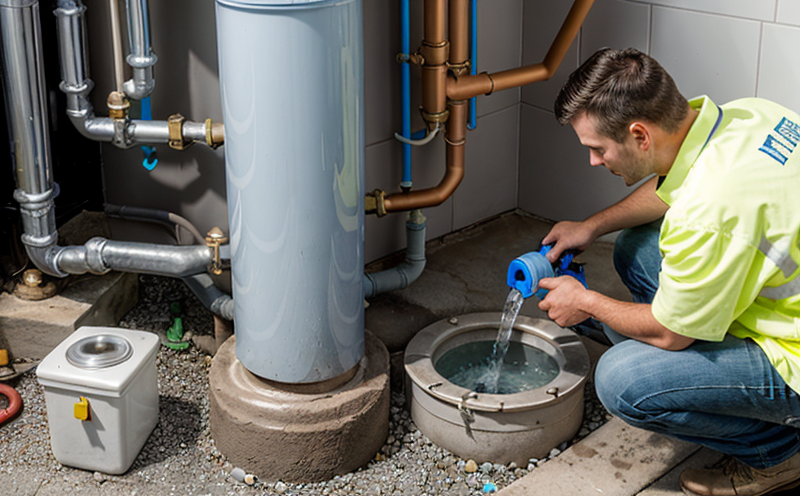EN 805-2 Water Supply System Verification
The EN 805-2 standard is an integral part of ensuring safe and reliable water supply systems in buildings and infrastructure. This method provides a comprehensive approach to verifying the integrity, functionality, and compliance of water supply systems with relevant European standards.
Water supply systems are critical components within any facility, providing essential services for daily operations and safety. Ensuring these systems meet stringent quality and reliability criteria is paramount to prevent contamination or failures that could lead to severe health risks or operational disruptions. The EN 805-2 method focuses on the following aspects:
- Visual inspection of the water supply system for any visible defects, leaks, or damage.
- Pressure testing and leak detection using appropriate instrumentation.
- Sampling and analysis to ensure compliance with drinking water standards (e.g., according to EN 17052).
- Validation of the system's design and installation against relevant codes and standards.
The process involves a multi-step approach, starting from initial setup, where we review the existing documentation and drawings provided by the client. This ensures that all components are accounted for and that any potential issues can be addressed early in the process. Following this, an in-depth inspection is conducted to ensure all parts of the system conform to design specifications.
Once the initial setup and inspection phases are complete, we proceed with pressure testing using specialized equipment such as hydraulic testers. The test aims at identifying any leaks or weaknesses within the piping network under a specified pressure level that simulates real-world operating conditions. This step is crucial because it helps in pinpointing areas requiring repair or replacement before they become critical points of failure.
Following the pressure testing phase, we conduct water sampling and analysis to assess the quality of potable water according to EN 17052 guidelines. These tests check for contaminants including bacteria, heavy metals, organic compounds, among others. The results provide valuable insights into whether the system meets legal requirements set forth by health authorities.
Finally, after completing all these steps, we compile our findings and produce a detailed report summarizing the condition of the water supply system based on EN 805-2 criteria. This document serves as evidence that the system complies with applicable regulations and best practices, thereby safeguarding public health and ensuring continuous operation.
This rigorous verification process not only helps maintain high standards but also identifies areas for improvement. By adhering to EN 805-2 guidelines, organizations can enhance their reputation by demonstrating commitment to safety and quality while simultaneously reducing risks associated with non-compliance penalties or lawsuits resulting from compromised water supplies.
Scope and Methodology
The scope of EN 805-2 includes the verification of water supply systems to ensure they meet the necessary standards for safety, reliability, and compliance. This involves several key steps:
- Initial setup involving review of existing documentation.
- In-depth inspection focusing on design conformance and visual checks.
- Pressure testing using hydraulic testers to detect leaks or weaknesses.
- Water sampling and analysis according to EN 17052 for contaminant levels.
The methodology ensures thoroughness throughout the verification process, addressing both structural integrity and water quality aspects. Each step contributes significantly towards achieving accurate results that reflect actual performance conditions in real-world scenarios.
For example, during the pressure testing phase, we use advanced instrumentation capable of maintaining precise control over applied pressures while monitoring for any signs indicative of leaks or malfunctions. Similarly, when conducting water sampling and analysis, our laboratories adhere strictly to internationally recognized procedures outlined in EN 17052 to ensure consistent and reliable data.
The combination of these methods guarantees a holistic assessment of the entire water supply system, ensuring no aspect goes unexamined. This approach fosters confidence among stakeholders regarding the overall quality and safety of the infrastructure being tested.
Benefits
Implementing EN 805-2 for water supply system verification offers numerous advantages that contribute to enhanced facility performance, improved compliance with regulations, and better overall management:
- Enhanced Safety: Regular verification reduces the risk of contamination or failures leading to potential health hazards.
- Compliance Assurance: Ensures adherence to relevant European standards like EN 17052, minimizing legal risks and penalties.
- Potential Cost Savings: Early identification of issues prevents costly repairs or replacements down the line.
- Better Reputation: Demonstrating commitment to quality and safety can significantly improve an organization's image.
By leveraging EN 805-2, facilities maintain optimal operational conditions necessary for smooth day-to-day activities while also safeguarding public health. This proactive approach sets a benchmark for excellence in water supply system management.





